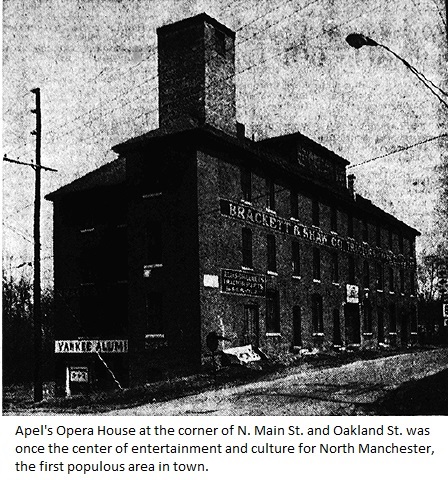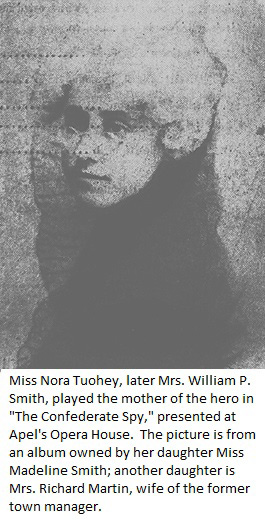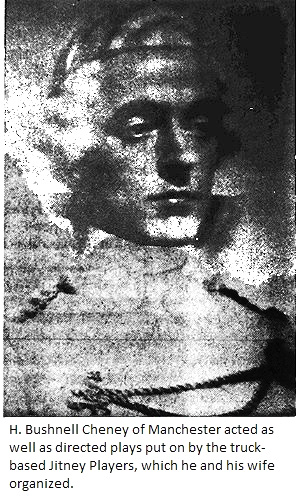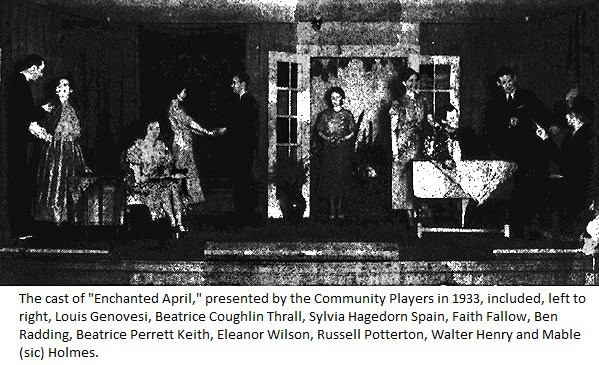
REPRINTS

Webmaster's notes: In the early days of the Manchester Historical Society, members wrote articles about the
town's past, which were published in The Manchester Evening Herald. This article, author unknown, was found and
copied by Dick Jenkins and transcribed by volunteer Maureen Hevey in 2018.
� Susan Barlow, webmaster.
The story of theatrical performances in Manchester -- professional or amateur theater -- is two-sided --
Manchester people as audience and as participants; maybe even three-sided, taking into account Manchester people
who made a living as professionals and became known outside of Connecticut.
One thinks first of Cheney Hall, built in 1867 by the silk manufacturing family, and of Apel's Opera House,
built "over north" by B. C. Apel, furniture dealer and undertaker. One thinks of the Community Players, oldest
(35 years last June) company in Connecticut continuously active, of the Little Theatre of Manchester, presently
hopeful of its own auditorium, of the Gilbert and Sullivan Workshop, seen recently in a 20th anniversary
production of "Trial By Jury" and "H.M.S. Pinafore."
But surely there was professional theater before the late 19th century. Let's have a setting for our story.
Entertainment, public and private, probably yes; theater as we know it now, almost certainly not. The people
who settled in Connecticut were the serious-minded, too strait-laced to be beguiled by play-acting.
The first theatrical performance in Hartford was an amateur show in May 1778, presented in the first State
House in Hooker Square -- not the present Old State House, but the building which preceded it.
The title was "Tancred and Sigismunde," and, for its presentation The Junior Sophister [sic] Class rented
-- had the audacity to rent is a phrase better expressing the reaction of some, at least, of their audience
-- the State House because no hall was available for them in Glastonbury, where they'd been relocated from New
Haven because of the war. The production cost them 60 pounds and the whole project was regarded, at very best,
in the light of an ill-advised prank.
In 1794, Hartford's first real theater, especially designed and built for playacting, opened on Temple St.
near Main. Professional repertory companies appeared there for five seasons. One play, "A Child of Nature,"
by Mrs. Inchbald, was followed by a favorite farce entitled "Love a La Mode."
There were occasional Shakespeare plays, including a David Garrick showing of "The Taming of the Shrew,"
re-titled "Catherine and Petruchio."
Did Orford Parish people attend these shows? It's possible but it seems unlikely. Traveling 10 miles then
was more difficult than traveling 50 miles now.
In 1800, the General Court, or Assembly, meeting on the second Thursday in May, passed an "Act to prevent
theatrical shows and exhibitions.
"Whereas theatrical entertainments lend to the depravation of the manners and impoverishment of the people...
"Be it enacted by the Governor and the House of Representatives in General Court assembled� that there shall
be no tragedies, comedies, farces and other dramatic pieces or compositions or pantomines [sic] or other
theatrical shows whatsoever to which admission can be charged with view to gain..."
The fine for a violation was $50.
Efforts were made several times in the 50 years following to have the Blue Laws changed; the General
Assembly, pointing to the number and quality of schools and colleges in Connecticut , and asserting that people
trusted their children to those institutions because of Connecticut's freedom from corrupting influences, held
the line.
Not until 1862 was a bill enacted which made possible the licensing of theatrical or other productions by
selectmen or city authorities.
The importance of Cheney Hall, dedicated in 1867, in the social and cultural life of Manchester has been noted (Jan. 26, 1966). This was -- to state the obvious -- a non-commercial venture. Concerts were held there, recitals, lectures, amateur theatricals. On some occasions the Cheneys arranged for a special train from New York to bring guests or performers. Once at least, Mark Twain came out from Hartford to witness a performance.
 In the 1880's Mr. Apel built his opera house at the juncture of N. Main and Oakland Sts.
In the 1880's Mr. Apel built his opera house at the juncture of N. Main and Oakland Sts.
It was a period when many New England towns, even villages, had similar structures. They were called opera
houses rather than theaters, perhaps as a gesture toward respectability or perhaps as a gesture toward elegance.
All those cities in Europe could have opera houses, why shouldn't we in New England? (The writer remembers two
other opera houses. One was in northern New Hampshire and recollection groups under one roof -- is it possible?
-- a minstrel show and the firehouse. The second was simply a huge bare barn of a second-story room over a row
of drug and dry goods and paint stores. It was used -- as was Apel's Opera House -- for such early movies as
"Hearts of the World" and "Way Down East", for prize speakings, graduations, high school junior proms, town
meetings, basketball games, and who remembers what else? To people who had never seen or heard an opera, the
name was accepted without question.)
When it became known that the Historical Society was interested in what went on at Apel's, there were a few
phone calls, reminiscences. A note from an old church bulletin revealed that Mr. Edison's new motion pictures
were shown in November 1899, for the benefit of the Second and the North Methodist Churches. Between reels,
slides were projected upon the screen for audience singing. One song was "Way Down East Among the Shady Maple
Trees."
One show was "Way Down East." It seems safe to assume that "The Old Homestead" was another, that the
old-fashioned melodramas were presented by the road companies which played Manchester. Were they the same
companies which played after 1896 when Parson's Theater, seating 1700, was built in Hartford? Probably not;
certainly in the early 1900's, New Haven's Shubert, Parson's, and Boston's Shubert were the usual professional
sequence.
"Uncle Tom's Cabin," with a band and bloodhounds for a parade, made the news columns of the Hartford Courant
but not because the advance agent was generous with tickets. The story is better than that.
Principal Frederick Lillie of Union School had warned his pupils that, go to the parade they might, but be
late for school in consequence they might not. Of course, they did and they were -- and Principal Lillie lined
them up at the schoolhouse door and whaled them, one by one, as they went in.
All but one, James Duffy, formerly of Henry St. and now of Nantucket, Mass., tells the story: he had a job
leading one of the hounds in the parade. This was a reasonable excuse for tardiness.
There were burlesque shows at the Opera House, Duffy recalls. He and Billy Apel, son of the owner, sneaked
into the building, rode in the freight elevator used to store furniture in the attic above the theater, and
watched the shows from the shelter of balcony seats.
Mention Apel's to older members of St. Bridget parish and they recall the stories told by their parents of
the YMCA , which then meant the Young Men's Catholic Association, and of St. Bridget's Dramatic Club, which
raised money for the building fund.

"A Confederate Spy, or The Blue and the Grey," in five acts, was one title. It was presented on Thanksgiving
eve, Nov. 27, 1889, followed by a turkey supper at Apel's lower hall and dancing with W. P. Smith as caller.
Buses ran to Vernon and to South Manchester after the dancing.
W. P. Smith (the late William P. Smith of Golway St.) played the spy, and Miss Nora Tuohey, later Mrs.
Smith, played his mother, with white wig and spectacles borrowed from a neighbor. Michael Tuohey, Hartford
Courant reporter for many years, was the policeman, and the heroine was Julia A. Harrington, later Mrs. Richard
J. Maloney.
Other members of St. Bridget's Dramatic Society were Barney Horn, the comedian; John Gill, who played the
villain; Daniel Sullivan, who liked blackface roles (minstrels?); Sadie Wall, Mrs. Edward Wall, the leading lady.
Some productions were taken to Rockville. The cast would go to Rockville early in the day, rehearse in the
afternoon, parade in costume to the hotel for supper (good publicity) and come home after the show.
The Opera House was used for other purposes than theatre -- for school graduations before any school had a
suitable auditorium; for exhibitions of art and other work done by students; for church fairs.
"Yesterday, the Jitney Players parked their cars and pitched their tents in a vacant lot near Rutland High
School," this reporter wrote about 1928 in a story for the Rutland, Vt. Herald -- and, by some good fortune, was
able to see all the Gilbert and Sullivan performances which the Jitney Players gave in their week's stay there.
 The Jitney Players gave a performance of Richard Sheridan's "A Trip to Scarborough" on June 13, 1928, in
Educational Square in downtown Manchester. It was the first production of the 150-year-old play in American
[sic] and of especial interest to Manchester because the Jitney Players had been originated and organized six
years earlier by H. Bushnell Cheney, recently graduated from Yale, and his wife, Alice Keating. Bushnell Cheney
was the son of Horace Bushnell Cheney.
The Jitney Players gave a performance of Richard Sheridan's "A Trip to Scarborough" on June 13, 1928, in
Educational Square in downtown Manchester. It was the first production of the 150-year-old play in American
[sic] and of especial interest to Manchester because the Jitney Players had been originated and organized six
years earlier by H. Bushnell Cheney, recently graduated from Yale, and his wife, Alice Keating. Bushnell Cheney
was the son of Horace Bushnell Cheney.
The unique mobile theater, a one-ton Ford truck later named Jezebel, was adapted to double as a theater,
according to Cheney's specifications, by a maker of circus wagons. A circus tent-maker ran up the canvas which
completed Jezebel's transformation nightly into a stage. The side of the truck folded down on hinged legs to
form a platform. The roof over the driver's seat, supported by telescoping stanchions, was pushed down to form
an upstage area just big enough for a sofa. A rack under the truck carried four heavy supports which fastened
to the corners of the "stage" and, when these were in place, a network of smaller pipes could be raised like an
umbrella. Then the canvas top could be raised over the framework; canvas front curtains, side coverings and a
cyclorama, or backdrop, were hauled into place by stage hands who also sang, danced, played instruments, acted.
Jezebel carried actors, costumes, a cook stove and two tents. A second truck, Desdemona carried electrical
equipment, stage properties, individual luggage -- two suitcases and one make-up box per troup member. The
Puddle Duck, Cheney's side-car motorcycle, completed the caravan.
The Jitney Players presented dramas, comedies, tragedies, masques and fantasies -- "One-act plays never
before seen on the road," including the work of Ben Hecht, A. A. Milne, Moliere, and Gilbert and Sullivan.
For 17 years, the Jitney Players were a famous traveling company, ranging from New England to the Mexican
border. By their second season, there were 14 members, transported in two open Ford touring cars, leaving the
trucks for equipment. A generator truck with a cargo of 400 folding chairs and a canvas top to shelter the
audience was soon added. After Bushnell Cheney's death, Alice Cheney carried on, finally selling the company to
Ethel Barrymore Colt. World War II and gasoline shortages saw the end of the Jitney Players.
Manchester's Community Players, Connecticut's oldest dramatic group continually active, celebrated its 35th
birthday in June 1966, and honored its charter members: Mrs. Joseph L. (Mary Ann) Handley, founder of the
organization, Mrs. Mark Holmes and Louis Genovesi.
The Community Players had its start during the Depression in March 1931, when eight young people having
coffee together sympathized with the plight of one of their number who was president of the Lions Club. The
Lions Club was trying to set up a milk fund, he said, for hungry school children. "Let's have a play," they
said.
They wrote the script, found the songs, made up the dances, designed the scenery, browbeat their friends
into taking parts, borrowed costumes. Six weeks later "The Lion's Share" hit the boards. "It was not 'Oklahoma,' "said Mrs. Handley at the Players' 25th anniversary, "But it gave us something to do and a group of people got grease-paint in their veins."
Thirty-five years and 100 productions later, last June the charter members looked over the old scrapbooks,
re-read old press notices, remembered fondly Manchester clubs and organizations who have been their sponsors.
A ticket in the 1930's cost 40 cents; once a show was given for the benefit of the King's Daughters, whose
project was Thanksgiving baskets for the needy, and admission was paid with cans of food.
The intention was to function as a truly community theater, to include people from all walks of life and all
age groups. Eighth grade boys appeared in "Tom Sawyer," a retired school superintendent was cast as Mr. Lawrence
in "Little Women," a man who was to become town manager had the part of a policeman.
 The list of plays is impressive: "The Old Soak," "The Queen's Husband," "Biography," "The Enchanted April,"
"Accent on Youth," "Three Live Ghosts." In 1966-67, the schedule includes "Everybody Loves Opal" and "Ready
When You Are, C. B."
The list of plays is impressive: "The Old Soak," "The Queen's Husband," "Biography," "The Enchanted April,"
"Accent on Youth," "Three Live Ghosts." In 1966-67, the schedule includes "Everybody Loves Opal" and "Ready
When You Are, C. B."
In September 1946, the Center Church bulletin included a notice that "A drama group is to be formed in Center
Church . . . The first meeting will be held Oct. 18. Mrs. Skinner (the late Helen Page Skinner, for many years
Manchester High School drama coach) will preside at the first session."
The drama group was expected "to assist the education committee, supply religious dramas for church groups,
present seasonal plays and pageants, entertain local clubs and present plays for the general public."
Thus began several years of intense activity on the part of a small membership which was known as the Center
Thespians. Their first production, "The Rock," was presented four or five times in the church. The second was
an original play, "Barabbas." Both were religious plays. They were followed by a heavy schedule of four or
five plays a year, ranging from "Blithe Spirit" to "Pygmalion" to "The Glass Menagerie." "Family Portrait" was
taken to the Bushnell auditorium in Hartford as a part of a Pilgrim Fellowship Rally.
In 1954 the Thespians did an original pageant, "The Pillar and the Ground," by Mrs. Millard (Ruth) Rowley
for the 175th anniversary of the church; other pageants were produced at Easter and at Christmas.
The Thespians were active in the Associated Little Theater, which represented little theaters from many
Connecticut towns and within which a one-act play contest was organized for each of several years. The
Thespians won several ALT awards for plays and for individual actors.
Mrs. Skinner was first president of the Thespians; others were George Munson, Dr. Samuel Pond, Merrill
Adams, A. William Astley, Charles Tindel, Mrs. Rowley and Mrs. Doris Belding.
Many of the Thespians became members of the Little Theatre of Manchester, organized in the fall of 1960 and
operated for some time under the aegis of the Manchester Recreation Department, then directed by James Herdic.
LTM is now independent. Its first season included "Bus Stop," "Time of the Cuckoo," and "Born Yesterday."
"Look homeward Angel" was its first production of 1967.
In 1962, the LTM instituted the Children's Wing with a membership of more than 100. Mrs. Rowley was the
first chairman of this department. The first show was Maeterlinck's "The Bluebird." There were three original
musicales with the book written by Mrs. Rowley and the music composed by Mrs. Fred Blish III: "Alice in
Wonderland," "Toby Tyler," and "Little Pawnee Brother." A teen-age group put on one-act plays for several years,
presenting them at elementary schools, with one program of three short plays given at Rham [sic] High School in
Hebron.
Presidents of the LTM have been Fred T. Blish III, for two terms of office; William Campbell, Philip Burgess,
Mrs. Ralph (Betty) Lundberg, Archibald Stuart and Mrs. Rowley.
In 1966, production activities -- rehearsals, scene painting, and meetings -- moved from the old Howell
Cheney Technical School to rooms at 22 Oak St. The annual budget for 1967 runs to $8000; membership has grown
to 80 and the patrons' list from 125 couples to 540. LTM looks forward to owning a building.
Another anniversary in Manchester theatrical activity was celebrated in 1967 with the Gilbert and Sullivan
Workshop's "Trial by Jury" and "H.M.S. Pinafore." "Trial by Jury" was first presented in 1947 under the
direction of Bernard Campagna, tenor soloist at South Methodist Church, by the Epworth League of the church.
Since 1960, when the group was incorporated, Miss Martha White, music supervisor for the elementary schools,
has been director.
Three members of the original cast have been in productions every year: Virginia Ryan, Robert Gordon and
George Duncan.
Note: The "Manchester: Past Places, People" series is prepared under the direction of the Public Information Committee of the Manchester Historical Society.